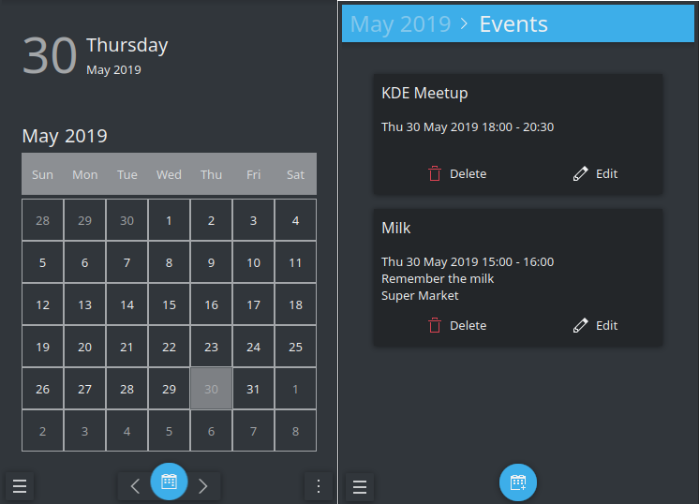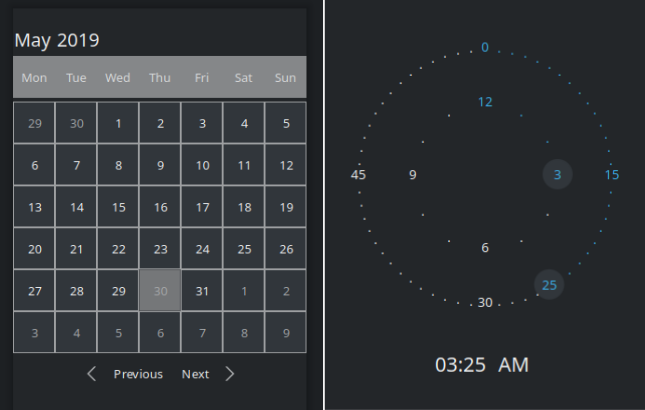About a year ago the phabricator tasks of Plasma Mobile were extensively revamped. We tried to make clear the objective of each task, providing helpful resources and facilitating onboarding. Looking at the features needed to reach the “Plasma Mobile 1.0” milestone, the calendar application was sticking out. So, Calindori was born (even though this name was coined some months later).
Build on top of Qt Quick and Kirigami and following -or trying to follow- the KDE human interface guidelines, the whole point of Calindori is to help users manage their time. Through a clean user interface, it aims to offer the users an intuitive way to accomplish their tasks.
 Calindori home and events pages
Calindori home and events pages
For the time being, Calindori provides the basic calendar functionalities: you can check previous and future dates and manage events and todos. Tasks and events of different domains (e.g. personal, business) can be included in different calendars, since multiple calendars are supported. Import functionality has also been added so as to make the transition of new users easier.
You may test Calindori at the moment, either building the 1.0 release from source or just installing the flatpak bundle. A Plasma Mobile phone is not a requirement for testing Calindori; it perfectly runs on Plasma or any other Linux desktop environment. It has been designed having in mind the needs of the mobile users, but the great advantage of using a framework like Kirigami is the adaptation of the user interface to desktop environments, with little or without additional development effort. It will also be very helpful to report issues and provide feedback on the gitlab repository.
Behind the scenes, the iCalendar standard is followed, as implemented by the KDE KCalcore library. KDE/Qt Developers may also find interesting the date and time pickers included in the application. These components may be reviewed, enhanced and, why not, find their way to the KDE frameworks.
 Calindori date and time pickers
Calindori date and time pickers
Looking to the future, the support of repeating events and reminders are the first tasks that should be handled. Then, caldav should also be supported, enabling the users to synchronize their online calendars (e.g. Nextcloud). Nevertheless, that’s a task that should be discussed with the rest of the Plasma Mobile team. The next KDE Akademy at Milan in September will be a great opportunity.
The Plasma Mobile team has made a significant progress during the last months, trying hard to offer a KDE Plasma experience to the mobile users. Even though it is not an 100% complete mobile platform, the missing parts are slowly being added to the software stack. But a lot of interesting tasks are still available, waiting for people willing to help the Plasma Mobile ecosystem grow.
In the next months a set of devices -like PinePhone and Librem 5- are expected, enabling the execution of Linux distributions on real mobile hardware. This will change significantly the free software mobile environment; it will open the way for more privacy friendly devices that could put the users in the driver’s seat, without spying on them or treating them like products. I believe it is the perfect time to get involved with projects like Plasma Mobile, helping to create an open mobile platform that will bring a KDE breeze to mobile phones.